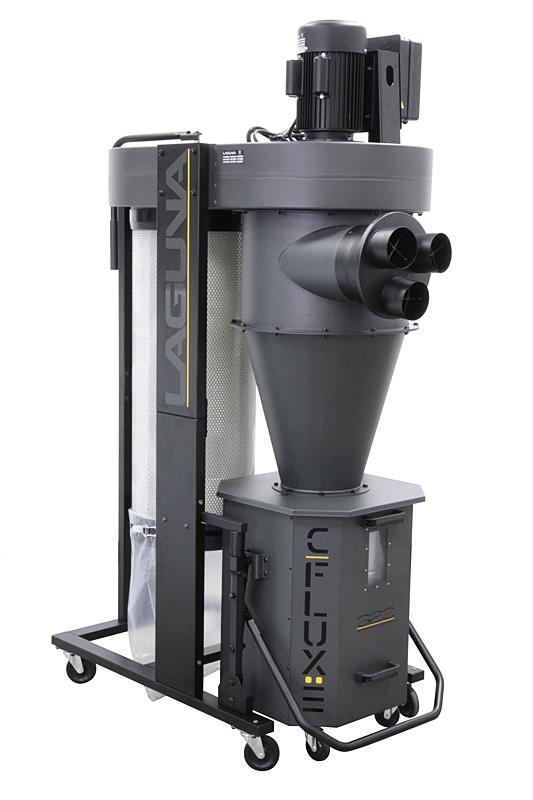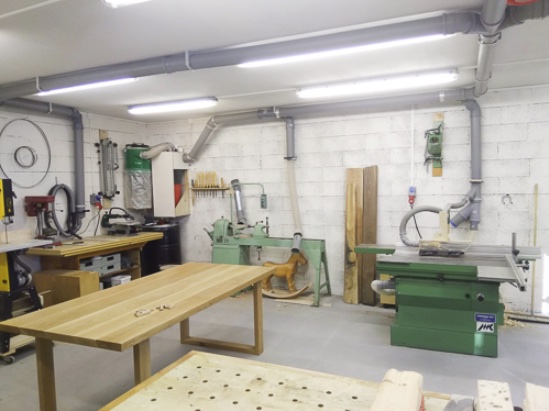WINTER CAMPAIGN - Selected Record Power machines and accessories with Special prices! - CHECK HERE
 READ MORE
READ MORE
WINTER CAMPAIGN - Selected Record Power machines and accessories with Special prices! - CHECK HERE
 READ MORE
READ MORE
 Login
Login

We're happy to spend hundreds of euros on a new tool or machine, but we'll continue to work in the middle of the dust because it feels foolish to pay for extraction that doesn't so obviously affect our work.
Wood dust is really fine, its size is measured in microns. While the human respiratory system is nicely designed to filter out larger particles, nothing prevents all the smallest particles from entering our lungs. These small particles gradually accumulate in the lungs, and their effects may not be noticed until it is too late. Fine dust also accumulates on all surfaces, so when you lift a paint can off the shelf, you may accidentally inhale a month’s dose of dust at a time when the dust on top of the can is airing.
Wood dust is also a serious fire risk. 100 grams of dust per cubic meter is sufficient to form a flammable mixture. You just need to spark in the wrong place at the wrong time and you’re about to think about building a new workshop if you’re no longer there yourself.
Accumulating debris also has a negative effect on the operation of the machines. The parts of the machines no longer move smoothly when the mechanisms are full of wood waste. The quality of your work suffers significantly if the workshop is messy.
The proper debris removal system is installed immediately at the dustbin, ie on the machine that produces the dust. In smaller workshops, a smaller mobile chewing extractor works well, while in larger rooms, it is advisable to consider a more solid solution. An efficient chewing extractor can be mounted on a wall, for example, and made of fixed pipe pulls for each machine. In addition to the vacuum cleaner, it is recommended to use an air cleaner that removes airborne dust without the need to connect it to any machine.
Unfortunately, there is no single machine that does it all, but there are good universal debris extractors. The vacuum cleaners are divided into two upper categories, namely high-volume-low-pressure (HVLP) machines and high-pressure-low-volume (HPLV) machines. As a good comparison, one could say that HVLP vacuum cleaners are like a car in 5-speed. They get strong, but they don’t accelerate quickly. Again, HPLV vacuum cleaners operate at low gears 0-100 efficiently, but do not get there at top speeds. The same goes for the service life of the vacuum cleaners, HVLP vacuum cleaners are made for continuous use, while HPLV vacuum cleaners are mainly used when they are needed.
High Volume-Low Pressure Principle (HVLP)
On machines of this principle, dust and chips are sucked through the propeller into a bag under the machine. Air is blown through the filter bag above the lower bag into the workshop air. The problem with this system is that the bag of the cheaper models does not filter out the smallest particles that are the most dangerous to health. For example, the Record Power collection does include particulate filters for machines of this principle, but they are valuable.
High-volume, low-pressure machines are made especially for machines that make large chips, such as planer planers. They are not optimally suited for use with low dust machines such as saws or grinders.
High Pressure-Low Volume Principle (HPLV)
HPLV vacuum cleaners move less air, but at significantly higher pressures. The principle of operation is similar to that of household vacuum cleaners, but they are better suited for continuous use and have a significantly higher waste capacity than basic vacuum cleaners. They are also able to filter out small particles that are harmful to health (up to 0.5 microns) and are very suitable for small spaces where the ventilation system moves indoor air.
The canister type vacuum cleaner is very easy to move. They have a blown motor built around a replaceable filter. There is still a paper bag on top of the filter, providing two-stage efficient filtration. There are big differences between the manufacturers, so when making a purchase decision, it is worth looking at the technical data of the machine to see how small particles the vacuum cleaner is able to filter and how much air it moves.
Usually, vacuum cleaners have a 100mm chip removal connector, so it sticks directly to woodworking machines. With the reducers, you can also attach the same vacuum cleaner to power tools with a 50 and 32mm connection. The reduction also significantly improves suction.
Some HPLV machines have an automatic start, which is really handy when using power tools. The vacuum cleaner starts at the same time as the power tool and when the tool is switched off, the vacuum cleaner closes after a few seconds, emptying the hoses. Make sure that the power of the machine you are using does not exceed the capacity of the automatic starter.
If you use a vacuum cleaner to vacuum the floor of your workspace, be careful not to get the hose stuck to the floor, as it may break the chewing bag or damage the engine. For example, Festool sells cleaning kits for its vacuum cleaners, so they can handle all kinds of cleaning needs.
Wood waste is collected either in a plastic bag or in a solid drum. Because the suction is so efficient, the bag retracts, making some kind of support structure inside the bag necessary. When the vacuum cleaner is switched off, the waste settles to the bottom of the bag, creating space. The HPLV vacuum cleaner packs waste much tighter than the HVLP vacuum cleaner, so in some cases up to four times more waste can go into the same volume.
Many power tools collect dust in their own bags. Almost without exception, these bags do not filter out fine dust, so it is recommended to connect these machines to a separate vacuum cleaner.
Make sure you get a extraction system that will be in use. If, for example, the use of the system requires constant unplugging of the power cord and relocation of the machine, at least I would not do the whole thing. Ease of use is a big factor in using any machine, so get a system that will meet your needs for the future. The more machines there are in the system and the longer the pipe runs, the more efficient extraction you need.


100% Trustworthy online store with history
Expert customer service
Fast deliveries
Large selection directly from stock
No middlemen - save on the price
Learn about product use, demo videos, and the latest news and offers.
Order below and you will also receive discount points.
Hallitie 16 | Rovaniemi | Finland
045 4903310 (klo 10-15)
asiakaspalvelu (at) nettiverstas.fi
Customer service and sales:
Ma - Pe | 10.00 - 15.00
Webshop is open 24/7

